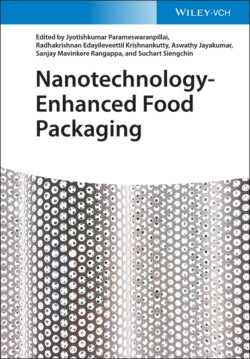Читать книгу Nanotechnology-Enhanced Food Packaging - Группа авторов - Страница 19
1.4.3 Bio-Based Nano-packaging in Food Industry
ОглавлениеBio-based nano-wrapping paper is a highly recyclable film used for food items for controlling moisture transfer and exchange of gas like CO2 and O2 for improved protection and for ensuring nutritional and sensory uniformity and reliability. Moreover, such type of materials in packaging are more socially friendly than conventional packaging films. As another type of packaging, biological packaging provides a barrier between consumer goods and their environment, thereby shielding them from harmful effects of microbes, relative humidity, and sunlight. The fundamental feature that separates biodegradable films from other packaging approaches is that the behavior of living things degrades these biodegradable sheets. This kind of body is the most common, as it is environmentally sustainable since all decomposition materials, e.g. carbon dioxide, biomass, and water, are fully reusable. Chemical packaging does not (or less) use fossil fuels to be used for consumer processing, and instead it uses green energy to recycle incineration power [34]. Therefore, nano-based bio-packaging sheets are very much popular these days due to their higher biodegradability than nonbiodegradable chemical sheets.
The promising design of bio-based nanocomposites for synthetic polymers drives new work on nanocomposites for use in food packaging. The classification of biopolymers is available in the literature. The use of nanotechnology on such polymers can offer new ways to improve both their properties and their cost-effectiveness. The most well-studied bionanocomposites are starch and derivatives such as polylactic acid (butylene succinate), polyhydroxybutyrate, and aliphatic polyester [35–38].
The three main applications of nanomaterial in food packaging were further described as the research trends in food packaging using nanotechnology, where nanoreinforcement, active nanocomposite packaging, and smart nanocomposites are mainly involved in food packaging. In active packaging, the well-known ingredients of antimicrobial packaging are silver, gold, and metal oxide nanoparticles. Silver nanoparticles found in several commercial applications are most widely studied. It may also be suitable for other active packaging fields, such as ethylene removers [39–43]. Nanosensors can respond to external changes in stimuli. The latest developments in smart food packaging polymer nanomaterials include indicators of oxygen, freshness, and pathogens [44, 45]. EcoSphere Biolatex® is a novel technology developed by the EcoSynthetix company. It is a biopolymer nanosphere with a granule size of 50–150 nm and a higher surface area than native starch. It possesses high solid dispersion in water. Native starch is replaced by EcoSphere Biolatex in adhesives. Instead of traditional adhesive, nanosphere starch is being used in McDonald's hamburger clamshell in the United States.
